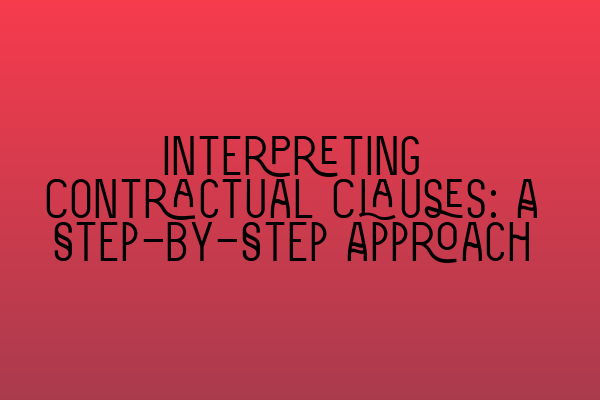Interpreting Contractual Clauses: A Step-by-Step Approach
Contractual clauses are the building blocks of any legally binding agreement. They define the rights and obligations of the parties involved and provide guidance on how the contract should be interpreted. However, interpreting these clauses can often be a complex task that requires careful analysis and consideration.
In this article, we will take you through a step-by-step approach to interpreting contractual clauses, helping you navigate through the intricacies and complexities of contract law. By following this approach, you can ensure that you are correctly understanding and applying the provisions of a contract, minimizing the risk of disputes and legal complications.
Step 1: Understand the Context
The first step in interpreting a contractual clause is to understand the broader context of the contract. This involves reviewing the entire agreement and identifying any relevant background information that may help shed light on the meaning of the clause. Consider any representations, negotiations, or industry practices that may influence the interpretation.
Related article: Unveiling Real-Life Case Studies: Insights into Legal Practice and Decision-Making
Step 2: Analyze the Language
Once you have understood the context, it’s time to analyze the specific language used in the clause. Look out for any ambiguous or unclear terms that may require further clarification. Consider using dictionaries or legal authorities to determine the ordinary meaning of the words used.
Related article: Exploring Solicitor Salaries in the UK: Average Earnings and Factors Affecting Income
Step 3: Consider Purpose and Object
Next, consider the purpose and object of the contract clause. What was the intention of the parties at the time of drafting the agreement? Understanding the underlying goals and objectives can help guide your interpretation.
Step 4: Examine External Factors
In some cases, external factors may impact the interpretation of a contractual clause. These factors can include legislative changes, industry regulations, or previous court decisions. Researching relevant legal precedents and staying up-to-date with any changes in the law can assist in determining the proper interpretation.
Related article: Mastering Client Relationship Management: Skills for Solicitors to Enhance Trust and Loyalty
Step 5: Apply the ‘Ejusdem Generis’ Rule
The ‘Ejusdem Generis’ rule is a principle often used in contract interpretation. It states that when a general term is followed by specific examples, the general term should be interpreted to include only things of the same kind or nature as the specific examples. Applying this rule can help to narrow down the scope of a clause.
Step 6: Consider the Entire Agreement
Finally, it is crucial to consider the contract as a whole. Ensure that your interpretation of the individual clause aligns with the overall intent and purpose of the agreement. Inconsistencies or conflicts between clauses should be resolved in a manner that gives effect to the entire contract.
Related article: Pursuing a Law School Education in the UK: Choosing the Right Path for Your Future
By following these six steps, you can approach the interpretation of contractual clauses with confidence and precision. Remember to always seek legal advice whenever necessary, as contract interpretation can be a complex and nuanced area of law.
Related article: Securing Training Contracts: A Roadmap to Becoming a Solicitor
In conclusion, understanding the step-by-step approach to interpreting contractual clauses is essential for any solicitor or legal professional. By analyzing the context, language, purpose, external factors, and applying relevant legal principles, you can navigate the complexities of contract law and ensure that contractual provisions are interpreted and applied accurately.
